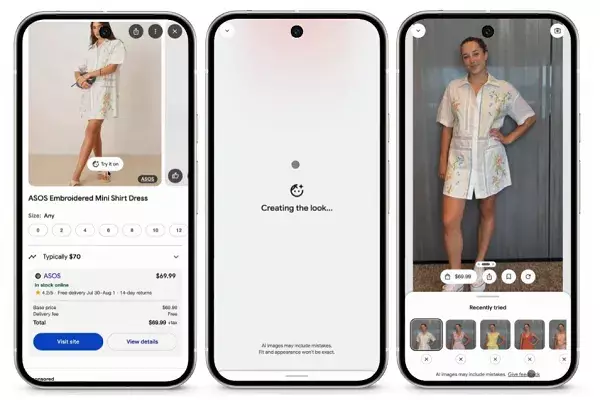Google’s latest innovation in the realm of digital commerce signals a significant shift toward immersive and personalized shopping experiences. The launch of AI-powered virtual try-on tools is not just an incremental upgrade; it’s a game-changer that redefines how consumers interact with online fashion. Previously limited to select users, this feature now extends its reach to the general U.S. audience, promising a more confident and intuitive shopping journey.
What sets this technology apart is its reliance on the user’s own selfie, elevating the traditional product preview into a tailored visualization. By uploading their image, consumers can see firsthand how specific clothing items might look on their unique body shape. This personalized preview simplifies decision-making, reducing the reliance on static images and static sizing guides, which often leave shoppers guessing. It bridges part of the experiential gap that online shopping has long struggled with, bringing a semblance of the in-store fitting room directly into consumers’ homes.
While the promise of such high-fidelity virtual try-ons is exciting, there’s an inherent challenge in accuracy. The realism of these previews can make or break their utility. If the AI can consistently provide convincing representations, it could revolutionize how we approach online apparel shopping — minimizing returns, increasing satisfaction, and fostering greater confidence in digital purchases. If not, skepticism will linger. Nonetheless, the potential to visualize clothing realistically before committing to a purchase propels Google’s tool beyond mere novelty toward a strategic enhancement of e-commerce.
Streamlining Price Vigilance with Smarter Alerts
Price conscious consumers stand to gain significantly from Google’s upgraded price tracking system. The new feature allows users to set detailed alerts — specifying not just the product but also their preferred size, color, and desired price point. In an environment where sales and discounts fluctuate rapidly, this granular approach is a much-needed antidote to the frustration of missing out on a deal.
What makes this implementation notable is its integration with Google’s extensive Shopping Graph, a comprehensive web of product data pooled from across the internet. This vast dataset ensures that users receive timely notifications whenever a desired item hits their specified price threshold. The automation reduces the ‘hunting’ effort, enabling shoppers to stay informed without constantly monitoring multiple stores or price comparison sites.
This innovation enhances the traditional wishlist or alert system by offering a more personalized, proactive approach. It nudges consumers toward smarter purchasing decisions, especially during high-sales periods like seasonal discounts or Black Friday. The ability to receive instant updates fosters a more strategic shopping mindset, potentially changing consumer behavior—shoppers will wait for optimal deals, influencing retailers’ pricing strategies indirectly.
Enhancing Search Precision with Natural Language AI
Another pivotal aspect of Google’s new shopping tools is the introduction of text-based, conversational search capabilities. Moving beyond keyword searches, users can now articulate their preferences in natural language, describing the style or type of product they desire. Google’s improved AI understands these nuanced descriptions, delivering more relevant and personalized matches.
This shift toward conversational commerce signifies a desire to make online shopping more intuitive. Instead of sifting through endless listings, shoppers can simply tell Google what they’re looking for — “find me a vintage leather jacket under $200” or “show me summer dresses in pastel shades.” This ease of use removes friction and caters to the modern consumer’s expectation of seamless, human-like interactions with technology.
Such AI-driven search advancements harness the power of natural language processing to improve discovery. They also open the door for a more emotionally connected shopping experience, where users feel understood and catered to in a conversational manner. If executed well, this feature could mark a new standard for retail search, making product discovery more akin to chatting with a knowledgeable friend than wading through an endless catalog.
The Future of Digital Shopping: A Fusion of Confidence, Convenience, and Personalization
Collectively, these innovations reflect a strategic push by Google to cement itself as a leader in AI-driven retail solutions. By enabling virtual try-ons, more precise price alerts, and conversational search, the company leverages cutting-edge technology to remove barriers that have historically hampered online shopping: uncertainty and inconvenience.
For consumers, this means more confidence with every purchase, less time spent chasing deals, and a more engaging, personalized experience. For retailers, these tools could translate into lower return rates, better customer satisfaction, and deeper insights into shopper preferences.
However, the true test remains in execution. The realism of virtual try-ons, the reliability of price alerts, and the contextual understanding of conversational searches will determine the long-term success of these tools. If Google manages to address these challenges, its new AI-powered shopping features could shape the retail landscape for years to come, turning online shopping into a more confident, customized, and enjoyable endeavor.


Leave a Reply